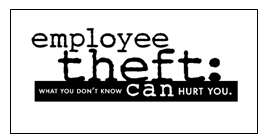 As I sit here on this Halloween night, thinking about how great it was when I was a kid to pillage the neighborhoods for candy and treats, I can’t help but also think about the next 60 days. The real fright comes now for all of us in the retail game. We’ve got so little time to do so very much. We all have new receipts pouring in, plan-o-grams that need setting, bulk stacks that need stacking and bins that need filling; all with the mad hopes of grabbing every possible dollar from now until December 24. A big part of that plan, for most, is hiring temporary help to get us through. Have you ever thought about how these temporary workers can impact your LP goals? With a little training and guidance, they can be one of your greatest holiday assets.
As I sit here on this Halloween night, thinking about how great it was when I was a kid to pillage the neighborhoods for candy and treats, I can’t help but also think about the next 60 days. The real fright comes now for all of us in the retail game. We’ve got so little time to do so very much. We all have new receipts pouring in, plan-o-grams that need setting, bulk stacks that need stacking and bins that need filling; all with the mad hopes of grabbing every possible dollar from now until December 24. A big part of that plan, for most, is hiring temporary help to get us through. Have you ever thought about how these temporary workers can impact your LP goals? With a little training and guidance, they can be one of your greatest holiday assets.
So, what LP practices should you train your temporary workers on? For starters, keep things simple. If you try and overload them with knowledge, you’ll get nowhere fast. I usually run with 5 big topics and expand upon them as needed.
- Customer service!
This should be priority number one! Honestly, this should be the priority for all training, regardless of status… Customer service is the absolute, hands down, no way around it, best possible way for you to discourage shoplifting. A thief loves to operate in the shadows. If a pesky employee is always there to lend a hand, well you’ll probably be putting a wrinkle in their plans. Make sure your temp hires understand that the service levels in your store should always surpass any other retailer. A customer should never be ignored, but enthusiastically greeted and assisted as if they were family. You’ll make more money from bigger baskets and the thieves will just hate you for it.
- Hot Spots
You know your building better than anyone, so you should know what the thieves love. Is it that rack of personal electronics on the rear aisle? Perhaps those new high end jackets you’ve got this year? Maybe even this month’s new footwear craze. Whatever it is, you undoubtedly know what it is. Well, Mr. Manager, make sure your temps know that information too! Explain what the hottest theft items are and have them be on the lookout for any suspicious activity near those items. Maybe they should call you if they see someone putting all 30 hover boards in a basket… just a thought.
- Look for suspicious activity
Easy for you and I; not so much for a high school/college kid’s first temp job in a retail store. Explain what this means to your temp crew. You know what your shopper looks like and how they shop. Train your temps to look for those tell-tale signs of potential funny business. You know, wearing the heavy coat, but it’s 85 and sunny outside (Maybe only in Louisiana’s winters…), clearing pegs, and all those other little bits of information that could help identify a thief.
- What to do?!
Well, your temps are paying attention to those hot items, happen to see a customer conceal an item, or they just have suspicions, what do they do now? GO TACKLE THEM! Or not… depending on your insurance, I guess. No, that’s a terrible idea, what they really should do is know how to react to such behavior should they observe it. This falls back to the very first training point above; go give em’ some good ole’ fashioned customer service. Don’t try to “watch” them, be overt with their presence. Your legit customers will love it, and if that person really did have fraudulent intentions, your temp just saved you some shrink dollars. Now, I would throw into this that if they do observe a crime, they need to know to report this to you immediately, preferably while the suspect is still in the store for you (or another manager) to handle.
- Safety
Did you really think we were going to talk about LP training and leave out our old friend safety? I never understand seeing debris or trash on the floor in a retail store. All those people working and no one can pick that shirt hangar off the floor? Does it really take an old lady to trip on it before we throw in to the trash? In my experience, GL/Worker’s Comp claims shoot through the roof this time of year. Make sure your temp crew understands your view/mantra/creed/constitution/mandate/stone tablet of what you expect in regard to safety. It’s not OK to climb on a gondola/shelf. It’s not OK to take a joy ride on the lips of the forklift. General frowned upon to ride a pallet-jack like a skateboard and also probably bad for business to leave water spills on the floor until someone decides to mop them up with the back of their shirts. Train them to be focused on unsafe actions/conditions and you may see a reduction in claims this season.
Not much work usually goes into training temporary workers, especially in a retail store. Normally, by the time you start to remember everyone’s name, it’s time to cut them all loose. Do yourself a favor and resist the urge to push people out to the sales floor with an index card’s worth of training. By putting just a little emphasis on LP practices in your temp training, I’ll guarantee that you’ll get a return on that small investment of time.
 Ever given any thought to your receiving area and your back door? How often do you open it and walk away? Do you require a manager be present when it’s open, or do you “trust” your warehouse crew with a key? Have you ever considered that an unattended back door could not only cause shrink, but also compromise the safety of your customer and employees? If you answered yes to any of those questions, you may have a problem.
Ever given any thought to your receiving area and your back door? How often do you open it and walk away? Do you require a manager be present when it’s open, or do you “trust” your warehouse crew with a key? Have you ever considered that an unattended back door could not only cause shrink, but also compromise the safety of your customer and employees? If you answered yes to any of those questions, you may have a problem. A good loss prevention plan starts with focusing on the basics. One of the basics is to monitor high risk merchandise. For a variety of reasons some items are stolen more often than others. It makes sense that they should be given extra attention and protection.
A good loss prevention plan starts with focusing on the basics. One of the basics is to monitor high risk merchandise. For a variety of reasons some items are stolen more often than others. It makes sense that they should be given extra attention and protection. We are getting ready for an increase in customer traffic. Is your Checkpoint System ready? Are you having false or phantom alarms? Is the system working properly? Have you had your system tuned or a Preventative Maintenance (PM) conducted in the last year or even 5 years?
We are getting ready for an increase in customer traffic. Is your Checkpoint System ready? Are you having false or phantom alarms? Is the system working properly? Have you had your system tuned or a Preventative Maintenance (PM) conducted in the last year or even 5 years?
 Ghosts, goblins, zombies, it’s that time of the year again to dust off the spooky movies and scary tales meant to put a chill up your spine. Hollywood always seems to have a batch of new releases ready about now to evoke nightmares and make us wake up in a cold sweat. We are sure that we see a poltergeist lurking in the corner of the bedroom or in the closet after we watch one of these films. Yes, I admit I am a big coward and have to put my hands over my face and peek out through my fingers to watch Freddy slash his next victim or Jason terrorize a group of kids at a camp in the middle of the woods. But there are real scary stories of my own to share that don’t have anything to do with ghouls. Mine are real-life scary stories of shoplifters I have dealt with during my years in retail Loss Prevention.
Ghosts, goblins, zombies, it’s that time of the year again to dust off the spooky movies and scary tales meant to put a chill up your spine. Hollywood always seems to have a batch of new releases ready about now to evoke nightmares and make us wake up in a cold sweat. We are sure that we see a poltergeist lurking in the corner of the bedroom or in the closet after we watch one of these films. Yes, I admit I am a big coward and have to put my hands over my face and peek out through my fingers to watch Freddy slash his next victim or Jason terrorize a group of kids at a camp in the middle of the woods. But there are real scary stories of my own to share that don’t have anything to do with ghouls. Mine are real-life scary stories of shoplifters I have dealt with during my years in retail Loss Prevention.


 forbid a competitive system). It is installed and your shoplifting losses go down. They will! The simple act of installing a system will make a percentage of your shoplifters go elsewhere.
forbid a competitive system). It is installed and your shoplifting losses go down. They will! The simple act of installing a system will make a percentage of your shoplifters go elsewhere.


 ch these live webinars as reasonably often as you need. Staff turnover, promotions, follow up training, one employee or fifty…. Just schedule the session. Oh, by the way. I will also provide you with 15 draft LP Policies and Procedures that you can customize to your operation. Shoplifting, employee theft, robbery, key control…..
ch these live webinars as reasonably often as you need. Staff turnover, promotions, follow up training, one employee or fifty…. Just schedule the session. Oh, by the way. I will also provide you with 15 draft LP Policies and Procedures that you can customize to your operation. Shoplifting, employee theft, robbery, key control…..